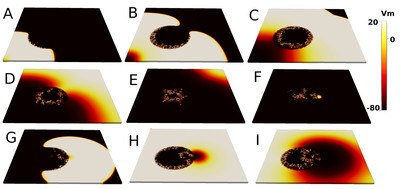Reentry and Ectopic Pacemakers Emerge in a Three-Dimensional Model for a Slab of Cardiac Tissue with Diffuse Microfibrosis near the Percolation Threshold
Nov 24, 2016
Alonso S, dos Santos RW, Bär M (2016). PLoS ONE 11(11): e0166972.
Arrhythmias in cardiac tissue are generally associated with irregular electrical wave propagation in the heart. Cardiac tissue is formed by a discrete cell network, which is often heterogeneous. Recently, it was shown in simulations of two-dimensional (2D) discrete models of cardiac tissue that a wave crossing a fibrotic, heterogeneous region may produce reentry and transient or persistent ectopic activity provided the fraction of conducting connections is just above the percolation threshold. Here, we investigate the occurrence of these phenomena in three-dimensions by simulations of a discrete model representing a thin slab of cardiac tissue. This is motivated (i) by the necessity to study the relevance and properties of the percolation-related mechanism for the emergence of microreentries in three dimensions and (ii) by the fact that atrial tissue is quite thin in comparison with ventricular tissue. Here, we simplify the model by neglecting details of tissue anatomy, e. g. geometries of atria or ventricles and the anisotropy in the conductivity. Hence, our modeling study is confined to the investigation of the effect of the tissue thickness as well as to the comparison of the dynamics of electrical excitation in a 2D layer with the one in a 3D slab. Our results indicate a strong and non-trivial effect of the thickness even for thin tissue slabs on the probability of microreentries and ectopic beat generation. The strong correlation of the occurrence of microreentry with the percolation threshold reported earlier in 2D layers persists in 3D slabs. Finally, a qualitative agreement of 3D simulated electrograms in the fibrotic region with the experimentally observed complex fractional atrial electrograms (CFAE) as well as strong difference between simulated electrograms in 2D and 3D were found for the cases where reentry and ectopic activity were triggered by the micro-fibrotic region.

Share: